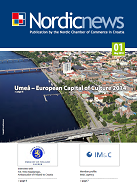Växjö sets sustainable example for Europe
The Swedish city of Växjö has been named Europe’s greenest city, reducing CO2 emissions per person by more than a third. What are the secrets of its environmental successes, and where will it go from here?If there something that Växjö has a lot of, it is fresh water and trees. This little city in southern Sweden is surrounded by dozens of lakes and millions of trees, and these natural resources have important roles in the story of how Växjö received the title “Europe’s greenest city” and how it hopes to live up to that honor.
The once-polluted lakes in and around the city have provided an important lesson in how environmental action at a local level can have an effect. The trees are a renewable resource with which the city is tackling some of today’s most pressing challenges: energy security and climate change.
Fossil-fuel free
Växjö was named “Europe’s greenest city” by the BBC in 2007, which led to massive interest in the city from policymakers, entrepreneurs and journalists from around the world eager to learn from its example. The visitors — two or three foreign delegations per week ever since — soon learned that Växjö had not jumped on the early 21st century’s environmental bandwagon but had in fact been cleaning up its act for years, even decades.
In 1996, for instance — one year before the Kyoto Protocol set binding targets for greenhouse gas emissions and raised awareness of climate change — the city decided to become fossil fuel free.
The key to Växjö’s achievements in reducing CO2 emissions is that about 90 percent of the energy used for heating in the city, and about half its electricity comes from trees. Waste from the local forest industry — branches, bark and sawdust — is burned to generate heat and power, and the Sandviksverket plant where this takes place has become a must-see for delegations on their study tours of Växjö.
Full article is available here.
Source: David Wiles, SWEDEN.SE, The Official Gateway to Sweden, September 2011


























